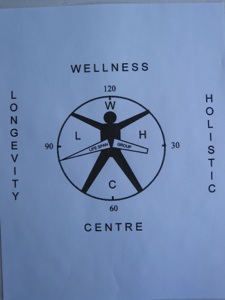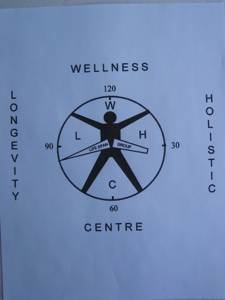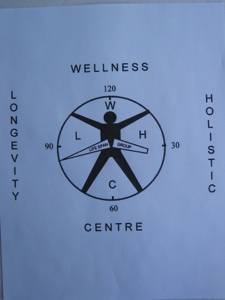Biological Clocks
Constructing a biological clock for an individual or a group, requires knowledge of survival curves.
Now you are ready to construct your own biological clock.

If you were illustrating the mean life expectancy of a similar group of Canadian white females on this biological clock, you would extend the minute hand to age 81. This is because white females in Canada generally outlive males by about 6 years.
Further adjustments have to be made to the biological clock depending on when you were born, your gender and where you live. For example, in the case of the ancient Romans, the minute hand or life expectancy would be only set to age 30. For North American white males born in 1900, the life expectancy was 48. By 1970, it had increased to 65 and today it approaches 80. Indeed, the mean life expectancy generally increases by more than 2 years for each decade.
Note the additional information about this biological clock:
> HOLISTIC (on the right) could be replaced by HEALTH (i.e. doctors and other health workers who extend your life expectancy through different forms of medical practice)
> LONGEVITY is the contribution of gerontologists (biologists who study the causes of aging) and how to extend life expectancy through scientific means.
> At the top of the clock is WELLNESS: efforts made by you, the individual, involving diet, exercise and other activities of healthy living
> At the bottom of the clock is CENTRE, which can refer to an institution which provides educational programs, or a club which offers medical information and/or other health based related activities
If we could actually make the clock run, we would see how certain life style changes, like weight reduction, exercise, or elimination of specific diseases such as cancer or heart disease, could add a number of years to a person’s life expectancy.
Draw a circle and add the numbers for a clock: 3, 6, 9 and 12 in their respective positions. Add a zero to all the numbers on the clock. Thus, 3 becomes 30, 6 becomes 60, 9 becomes 90 and 12 becomes 120 which represents the maximum human life span (in years).
The hour hand can be used to represent a population group (e.g. males in the Roman period or males at the beginning of the 20th century.) The hour hand can also be used to represent a specific individual on his or her own personal biological clock.
The minute hand represents the mean life expectancy for the population group or individual, that is the age in years of when they are expected to die.
On this clock, the hour hand represents a white Canadian male born at the end of the 20th century. The minute hand - or mean life expectancy - would therefore stop at age 78.

